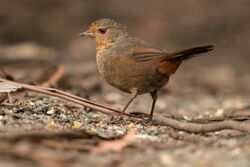Biology:Pilotbird
| Pilotbird | |
|---|---|

| |
| Pilotbird, Blue Mountains | |
| Scientific classification | |
| Domain: | Eukaryota |
| Kingdom: | Animalia |
| Phylum: | Chordata |
| Class: | Aves |
| Order: | Passeriformes |
| Family: | Acanthizidae |
| Genus: | Pycnoptilus Gould, 1851 |
| Species: | P. floccosus
|
| Binomial name | |
| Pycnoptilus floccosus Gould, 1851
| |
| Subspecies[2] | |
| |
The pilotbird (Pycnoptilus floccosus) is a species of passerine bird in the family Acanthizidae. It is monotypic within the genus Pycnoptilus. The species is endemic to south-eastern Australia .
Taxonomy
The species was first described by English ornithologist John Gould in 1851. The generic name Pycnoptilus derives from the Ancient Greek pyknos 'thick' and ptilon 'feather'.[3] Its specific epithet floccosus is Late Latin for 'flocked with wool'.[3] There are two subspecies: the nominate subspecies Pycnoptilus floccosus floccosus lives in alpine areas; and P. f. sandfordi lives in lowland forest.[4][5]
Description
The pilotbird is a large, plump species of acanthizid, measuring around 18 centimetres (7.1 in) in length and weighing 27 grams (0.95 oz).[4] The plumage of the underparts is reddish-brown with scalloping on the chest and the centre of the belly speckled dull white. The upperparts are chocolate-brown.[5][6] The bill is short and finely pointed.[7] Its tail is broad and semi-erect, and flicked up and down when feeding.[5][8]
Distribution and habitat
The pilotbird is found from the Wollemi National Park and Blue Mountains National Park in New South Wales through to the Dandenong Ranges, near Melbourne in Victoria.[9] Its natural habitat is temperate wet sclerophyll forests and occasionally temperate rainforest, where there is dense undergrowth with abundant debris.[10][7] It is sedentary and common.[7]
Behaviour
Its name comes from its supposed habit of following lyrebirds, taking prey that they flush, and also from its call guiding bushmen seeking for lyrebirds.[7] This habit is well known but seldom observed. The pilotbird is highly terrestrial, feeding on or near the ground and when disturbed it runs swiftly on strong legs.[7] Its call has been described as "piercing and sweet".[8] The male makes a far-carrying call of wit-wit-weet-WHEER to which the female may respond with a softer wit-a-wit-ee.[7][8][4]
Breeding
The breeding season for the pilotbird is from August to December.[7] The globular nest is built with a side-entrance and hidden amongst the accumulated debris on the forest floor.[7] It is an untidy construction of bark, ferns, dead leaves and rootlets.[8] A clutch of usually two eggs, each measuring 27 by 20 mm (1.06 by 0.79 in) and varying in colour from grey-green to purple-brown, is incubated by the female for 20–22 days.[7][8] During the nestling period, which lasts 14–17 days, the male will often feed the female or help with the care of the nestlings, if the female has a subsequent brood.[4] The nests are sometimes parasitised by the fan-tailed cuckoo (Cacomantis flabelliformis).[4]
Conservation
The pilotbird is fairly common within its small range, which has reduced as a result of forest clearance and urban development, but much of its habitat is within national parks or reserves.[4] Its habitat is also threatened by climate change, severe weather and bushfires;[10] nevertheless, the most recent assessment in October 2016 classified the pilotbird as vulnerable on the IUCN Red List.[10] The pilotbird was listed as Vulnerable under the EPBC Act in 2022,[11] in response to the 2019/2020 Australian Bushfires, which burnt 47% of its distribution, and contributed to an estimated 30-50% decline in the population.[12]
References
- ↑ BirdLife International (2022). "Pycnoptilus floccosus". IUCN Red List of Threatened Species 2022: e.T22704513A211212104. doi:10.2305/IUCN.UK.2022-3.RLTS.T22704513A211212104.en. https://www.iucnredlist.org/species/22704513/211212104. Retrieved 21 July 2022.
- ↑ Gill, F.; Donsker, D.; Rasmussen, P., eds (2020). IOC World Bird List 10.2 (Report). doi:10.14344/IOC.ML.10.2.
- ↑ 3.0 3.1 Jobling, James A. (2010). "Helm Dictionary of Scientific Bird-names". https://archive.org/details/Helm_Dictionary_of_Scientific_Bird_Names_by_James_A._Jobling. Retrieved 2020-04-20.
- ↑ 4.0 4.1 4.2 4.3 4.4 4.5 Gregory, Phil (2020). "Pilotbird (Pycnoptilus floccosus)". Birds of the World. doi:10.2173/bow.pilotb1.01.
- ↑ 5.0 5.1 5.2 Slater, Peter (1979). A field guide to Australian birds. 2: Passerines / Peter Slater (Reprint ed.). Adelaide: Rigby. ISBN 978-0-85179-813-4.
- ↑ Simpson, Ken; Day, N.; Trusler, P. (1999). written at Ringwood, Victoria (in en). Field Guide to the Birds of Australia (6th ed.). Penguin Books Australia: Viking. ISBN 978-0-670-87918-2. https://books.google.com/books?id=ao-ZAAAACAAJ&q=0670879185.
- ↑ 7.0 7.1 7.2 7.3 7.4 7.5 7.6 7.7 7.8 Morcombe, Michael K. (2003) (in en). Field Guide to Australian Birds. Steve Parish Pub.. ISBN 978-1-74021-417-9.
- ↑ 8.0 8.1 8.2 8.3 8.4 Pizzey, Graham (1989) (in en). A Field Guide to the Birds of Australia. Collins Publishers Australia. ISBN 978-0-7322-2436-3.
- ↑ "eBird map: Pilotbird". https://ebird.org/map/pilotb1. Retrieved 2020-04-20.
- ↑ 10.0 10.1 10.2 BirdLife International (2016). "Pycnoptilus floccosus". IUCN Red List of Threatened Species 2016: e.T22704513A93973392. doi:10.2305/IUCN.UK.2016-3.RLTS.T22704513A93973392.en. https://www.iucnredlist.org/species/22704513/93973392. Retrieved 13 November 2021.
- ↑ "Species Profile and Threats Database - Pilotbird, Pycnoptilus floccosus". https://www.environment.gov.au/cgi-bin/sprat/public/publicspecies.pl?taxon_id=525.
- ↑ Conservation Advice for Pycnoptilus floccosus (Pilotbird) In effect under the Environment Protection and Biodiversity Conservation Act 1999 from 2 March 2022. https://www.environment.gov.au/biodiversity/threatened/species/pubs/525-conservation-advice-02032022.pdf
Wikidata ☰ Q1585682 entry
 |


